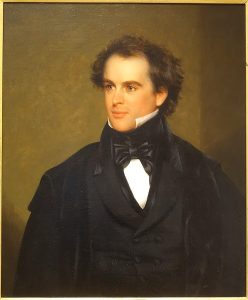In the 1840s, when Brook Farm was established, there were around thirty-five utopian communities in America. What set Brook Farm apart was its association with famous Concordians and its particular vision to unite both farmer and scholar in a single person.
Although Brook Farm was in West Roxbury, just south of Boston, it had strong connections with Concord from the beginning. The principles Dr. George Ripley founded Brook Farm on had been talked through at meetings of the Transcendental Club. In addition, people who had attended Margaret Fuller’s Conversations went to live at Brook Farm.
Elizabeth Peabody wrote two essays for The Dial in support of Brook Farm’s goals: “A Glimpse of Christ’s Idea of Society” and “Plan of the West Roxbury Community.” Although she never lived there, Peabody applauded the people “who had dared to say to one another… Why not begin to move the mountain of custom and convention?”
When Ripley, a former Boston preacher, invited Ralph Waldo Emerson to join his community, he described its goals:
“…to insure a more natural union between intellectual and manual labor than now exists; to combine the thinker and the worker, as far as possible, in the same individual…to do away with the necessity of menial services by opening the benefits of education and the profits of labor to all.”
Ultimately, Ripley wanted to “prepare a society of liberal, intelligent and cultivated persons, whose relations with each other would permit a more wholesome and simple life than can be led amidst the pressures of our competitive institutions.”
Even though these ideas overlapped with Emerson’s speech “The American Scholar,” Emerson declined the invitation to Brook Farm. In his journal, Emerson wrote, “I do not wish to remove from my present prison to a prison a little larger. I wish to break all prisons.” He added, “Moreover, to join this body would be to traverse all my long trumpeted theory, and the instinct which spoke from it, that one man is a counterpoise to a city.”
George Ripley, without Emerson, moved forward with Brook Farm. In 1841, the Community, formally called the Institute for Agriculture and Education, was established along with its constitution. Brook Farm was organized as a joint stock company, with each share being $500. Each shareholder could enroll a student at the school.
The school at Brook Farm was quite impressive. It welcomed a wide age-range of students and had an infant school, primary school, and a six-year preparatory school for college. True to Brook Farm’s overall mission, students spent an hour or two performing manual labor in addition to their lessons.
Life at Brook Farm required a lot of work. Chores included cutting straw, chopping hay, feeding cows, spreading manure, collecting firewood, planting potatoes, and harvesting squash and apples, among other things. The premise of the farm was to combine the worker and the thinker, and in some ways, George Ripley achieved this. He found that milking cows provided a nice environment for thinking, “particularly when the cow’s tail is looped up behind.”

One of the more famous people to buy into, live, and work at Brook Farm was the author Nathaniel Hawthorne. He lived there for just two seasons from Spring to Fall 1841. Unlike George Ripley, Hawthorne had trouble thinking and writing at the farm. Even so, life at Brook Farm had a lasting effect on him, and in 1851 he wrote The Blithedale Romance based loosely on his time there. In the preface of the novel, he described his time at Brook Farm as “certainly, the most romantic episode” of his life— “essentially a daydream, and yet a fact.”
George P. Bradford, who was a classmate of Emerson’s at Harvard, was one of the first people to join Brook Farm. Bradford taught in the school. Many of his students sang his praises. Frederick Pratt recalled that “I learned easier and faster with him than any other teacher I was ever under.”
Margaret Fuller visited Brook Farm often enough to have a designated bedroom, but she never stayed long term. Other visitors included Ralph Waldo Emerson, who gave informal talks at the main building, called the Hive. Edmund Hosmer, Concord’s most successful farmer and an early skeptic of the Community, stopped by for picnics and garden parties.

